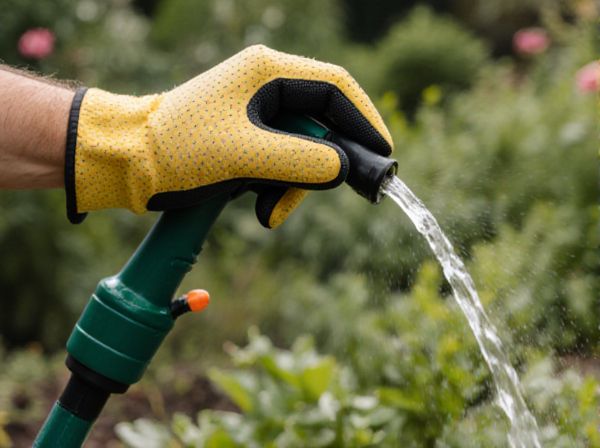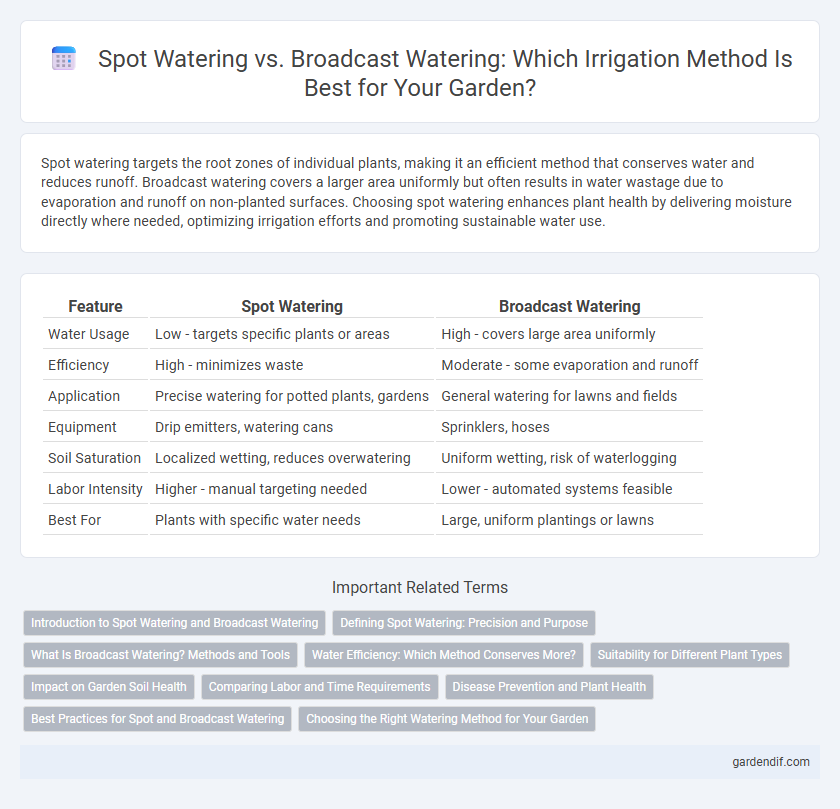
Spot watering vs Broadcast watering Illustration
Spot watering targets the root zones of individual plants, making it an efficient method that conserves water and reduces runoff. Broadcast watering covers a larger area uniformly but often results in water wastage due to evaporation and runoff on non-planted surfaces. Choosing spot watering enhances plant health by delivering moisture directly where needed, optimizing irrigation efforts and promoting sustainable water use.
Table of Comparison
| Feature | Spot Watering | Broadcast Watering |
|---|---|---|
| Water Usage | Low - targets specific plants or areas | High - covers large area uniformly |
| Efficiency | High - minimizes waste | Moderate - some evaporation and runoff |
| Application | Precise watering for potted plants, gardens | General watering for lawns and fields |
| Equipment | Drip emitters, watering cans | Sprinklers, hoses |
| Soil Saturation | Localized wetting, reduces overwatering | Uniform wetting, risk of waterlogging |
| Labor Intensity | Higher - manual targeting needed | Lower - automated systems feasible |
| Best For | Plants with specific water needs | Large, uniform plantings or lawns |
Introduction to Spot Watering and Broadcast Watering
Spot watering targets specific plants or areas, delivering precise amounts of water directly to the root zone, reducing water waste and promoting healthier growth. Broadcast watering distributes water over a wide area, covering lawns or garden beds uniformly but often with less efficiency due to evaporation and runoff. Choosing between spot and broadcast watering depends on plant type, soil conditions, and water conservation goals.
Defining Spot Watering: Precision and Purpose
Spot watering targets specific plants or areas with precise amounts of water, minimizing waste and promoting healthier growth by delivering moisture directly to the root zone. This method enhances water efficiency compared to broadcast watering, which distributes water evenly across a large area regardless of plant needs. By focusing on individual plant requirements, spot watering supports optimal hydration and reduces the risk of overwatering surrounding soil.
What Is Broadcast Watering? Methods and Tools
Broadcast watering involves evenly distributing water over a large area, typically using sprinklers, irrigation systems, or hose-end sprinklers. This method is ideal for lawns, gardens, and agricultural fields, promoting uniform soil moisture and healthy plant growth. Tools such as oscillating sprinklers, rotary sprinklers, and drip irrigation systems ensure efficient water coverage and minimize water waste.
Water Efficiency: Which Method Conserves More?
Spot watering targets the root zone of individual plants, significantly reducing water waste by minimizing runoff and evaporation compared to broadcast watering, which distributes water uniformly over a large area regardless of plant needs. Research indicates spot watering can conserve up to 50% more water than broadcast methods, especially in drought-prone regions. This precision in irrigation enhances overall water efficiency, promoting healthier plants with less resource consumption.
Suitability for Different Plant Types
Spot watering targets specific plants by delivering water directly to the root zone, making it ideal for deep-rooted or water-sensitive plants such as tomatoes and peppers. Broadcast watering covers a wider area, suitable for evenly hydrating lawns, ground covers, or densely planted flower beds that require uniform moisture distribution. Choosing the appropriate method ensures efficient water use and optimal plant health based on root depth, spacing, and moisture needs.
Impact on Garden Soil Health
Spot watering targets the root zones of individual plants, reducing water waste and minimizing soil erosion, which promotes healthier soil structure and microbial activity. Broadcast watering saturates large areas uniformly but can lead to surface runoff, increased soil compaction, and nutrient leaching, negatively impacting soil fertility and aeration. Efficient water application through spot watering supports optimal soil moisture levels, enhancing nutrient uptake and sustaining beneficial soil organisms.
Comparing Labor and Time Requirements
Spot watering targets specific plants or areas, drastically reducing labor and time by focusing efforts only where water is needed. Broadcast watering covers large areas uniformly, requiring more water, energy, and frequent monitoring to avoid overwatering or runoff. Spot watering enhances efficiency in labor and water use, while broadcast watering demands higher resources and time investment for effective management.
Disease Prevention and Plant Health
Spot watering targets the root zone of individual plants, reducing moisture on leaves and surrounding soil, which helps prevent fungal diseases such as powdery mildew and root rot. Broadcast watering applies water broadly, increasing leaf wetness and humidity that can promote pathogen growth and stress plants. Concentrated moisture control through spot watering supports healthier root systems and minimizes disease risk for enhanced plant vitality.
Best Practices for Spot and Broadcast Watering
Spot watering targets specific plants or areas, conserving water by delivering moisture directly to the root zone, which reduces evaporation and runoff; best practices involve using drip irrigation or soaker hoses to ensure deep penetration without over-saturation. Broadcast watering applies water uniformly over a larger area, making it suitable for lawns or young seedlings; optimal techniques include watering early in the morning or late in the evening to minimize evaporation and using sprinklers that distribute water evenly to prevent pooling and soil erosion. Both methods benefit from soil moisture monitoring to adjust irrigation frequency and volume, promoting water efficiency and healthy plant growth.
Choosing the Right Watering Method for Your Garden
Spot watering targets specific plants or root zones, minimizing water waste and ensuring deep hydration for individual plants, which is ideal for gardens with varied plant types or water-sensitive species. Broadcast watering distributes water evenly over larger areas, suitable for lawns or uniform garden beds but can lead to evaporation and runoff if overused. Selecting the right watering method depends on plant variety, soil type, and garden layout, optimizing water efficiency and promoting healthy growth.
Spot watering vs Broadcast watering Infographic

 gardendif.com
gardendif.com